Olive the German shorthaired pointer brings a spruce grouse to hand in the Chugach Mountains. Peter Wadsworth
FOR MOST upland hunters, Alaska’s winter effectively puts an end to their season long before regulations do. Some hunters turn to snowmachines, which are loud and cumbersome; others resort to snowshoeing, which is exhausting and inefficient. Peter Wadsworth spent 10 years skiing Vermont’s backcountry before moving to Anchorage seven years ago; he knew there was a better way.
At the time, Wadsworth wanted to use his skis to access ptarmigan country. Old-timers and newer locals alike told him the same thing: “You can’t hunt on skis. It doesn’t work.”
Most Alaskan skiers don’t hunt on skis, so the ones he chatted with didn’t have any suggestions. The long, skinny cross-country skis and old-school backcountry setups in their garages simply wouldn’t work to navigate the deep powder and steep terrain he had in mind.
So Wadsworth, now 44 and a full-time adventure photographer, drew on his extensive ski touring background—and plenty of trial and error—to find the right ski setup that could take winter bird hunters up where they needed to go, fill limits in snow up to 10 feet deep, and get them back down in short order. He experimented until he came up with the perfect recipe.

Jessie Janowski, Wadsworth’s hunting partner, applies skins to the bottom of her skis before climbing into the Chugach Mountains. Skins were originally made from animal hides (hence the name), but now they’re hi-tech strips of nylon and glue that allow wearers to gain elevation, glide on the flats, and slide downhill easily. While recreational skiers often remove their skins once they reach the summit, the hunters leave their skins on for the entirety of the hunt because it slows their descent and offers more control. “The first pair of skins I ever put on skis changed my life,” Wadsworth says. “They are my favorite piece of gear I’ve ever owned for any sport.” Some skis sold to hunters already have partial climbing skins or scales inlaid on the bottom, but Wadsworth has tried them all and found they do not provide the necessary traction for traveling in the backcountry while bird hunting. Full-size skins are best for climbing the steep slopes Alaska’s upland hunters encounter. Peter Wadsworth
His unique kit includes a pair of thick, short skis (better than long cross-country skis for maneuvering tight terrain) with lightweight bindings and ski mountaineering boots (a hard boot with more flex than the kind worn at a ski resort). Wadsworth has shared his setup with other hunters, and it’s gotten popular enough that a local ski shop immediately recognizes a Wadsworth disciple when someone wanders in to ask for this strange setup.
The real magic, however, happens with the final piece of gear: climbing skins. Most downhill skiers rely on chair lifts at ski resorts to carry them effortlessly up the mountain; obviously such luxuries don’t exist in the backcountry. Willow ptarmigan, Wadsworth’s main quarry, live in the snowy valleys outside Anchorage, but he can still gain up to 2,000 vertical feet on a hunt. Without skins, he wouldn’t be able to climb even 5 feet without sliding backward into creek bottoms or drainages.
Besides his own buddies, Wadsworth knows very few skiers who hunt like he does. (Scandinavians traditionally ski-hunt for ptarmigan, but they use .22 rifles and don’t run dogs.) He’s gotten some interest from hunters on his Instagram page, but estimates just 10 people ski-hunt like he does in the Anchorage area. Which is a shame, because not only is his method a ton of fun, it’s also incredibly effective. Instead of a brutally hard hike, Wadsworth’s hunting party glides up the terrain for half the journey and slides down the second half, allowing them to stay out longer, travel farther, and find more birds.
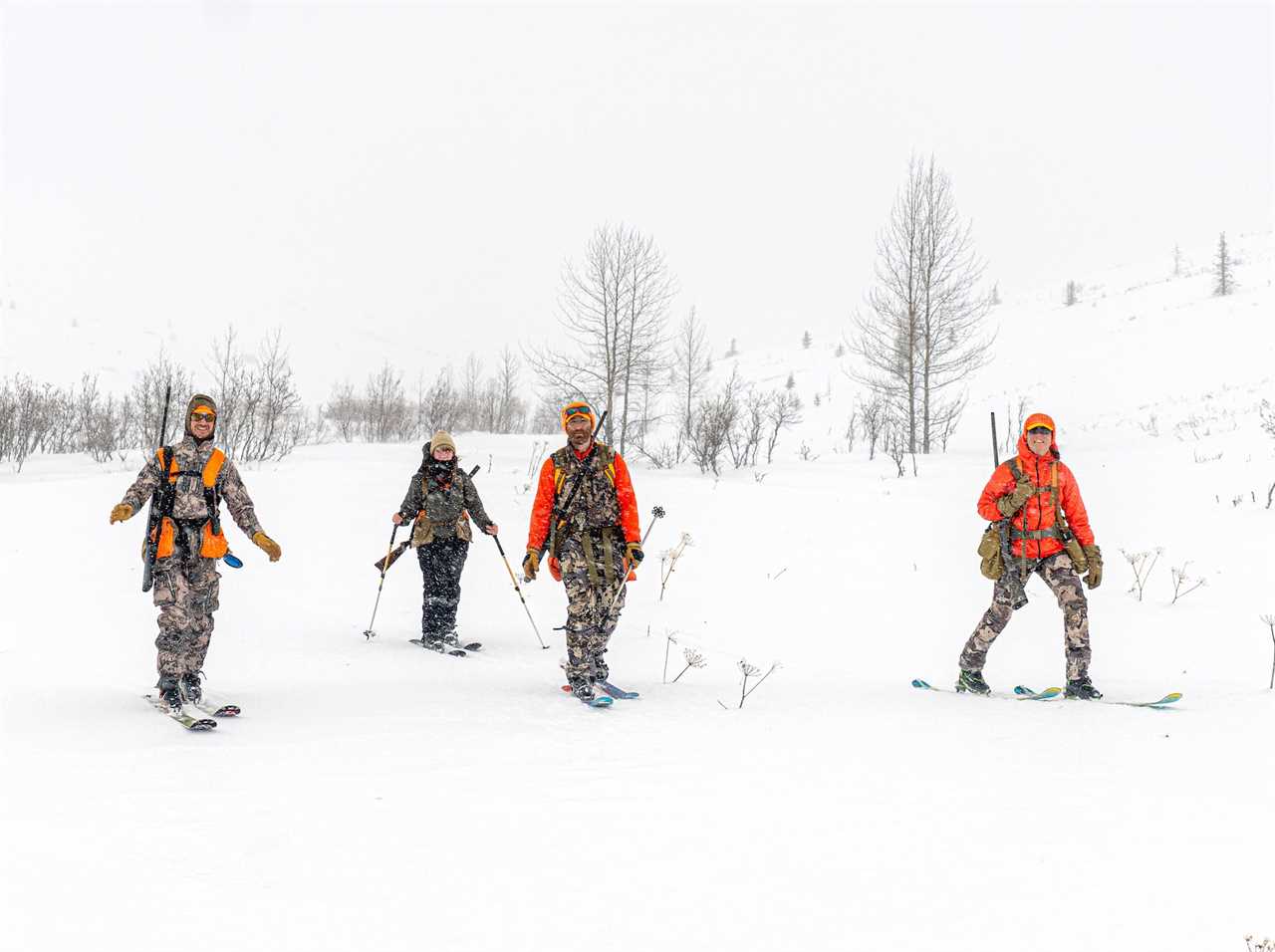
From left: Wadsworth’s buddies Tyler Overby, Emily Spolyar, Scott Johnson, and Jessie Janowski head into the Talkeetna Mountains for a March ptarmigan hunt. Spolyar, a conservation specialist for Pheasants Forever, added a sling to her shotgun so she could use ski poles on her first ptarmigan hunt. Poles can prove cumbersome if you’re already carrying a shotgun, but they’re worth the hassle for newer skiers who need a little extra purchase while traveling into bird country. When a dog goes on point, the skier simply plants their poles in the snow or clips them to their pack and unslings their shotgun. Experienced skiers tend to hunt without poles, relying instead solely on skins for traction. Peter Wadsworth
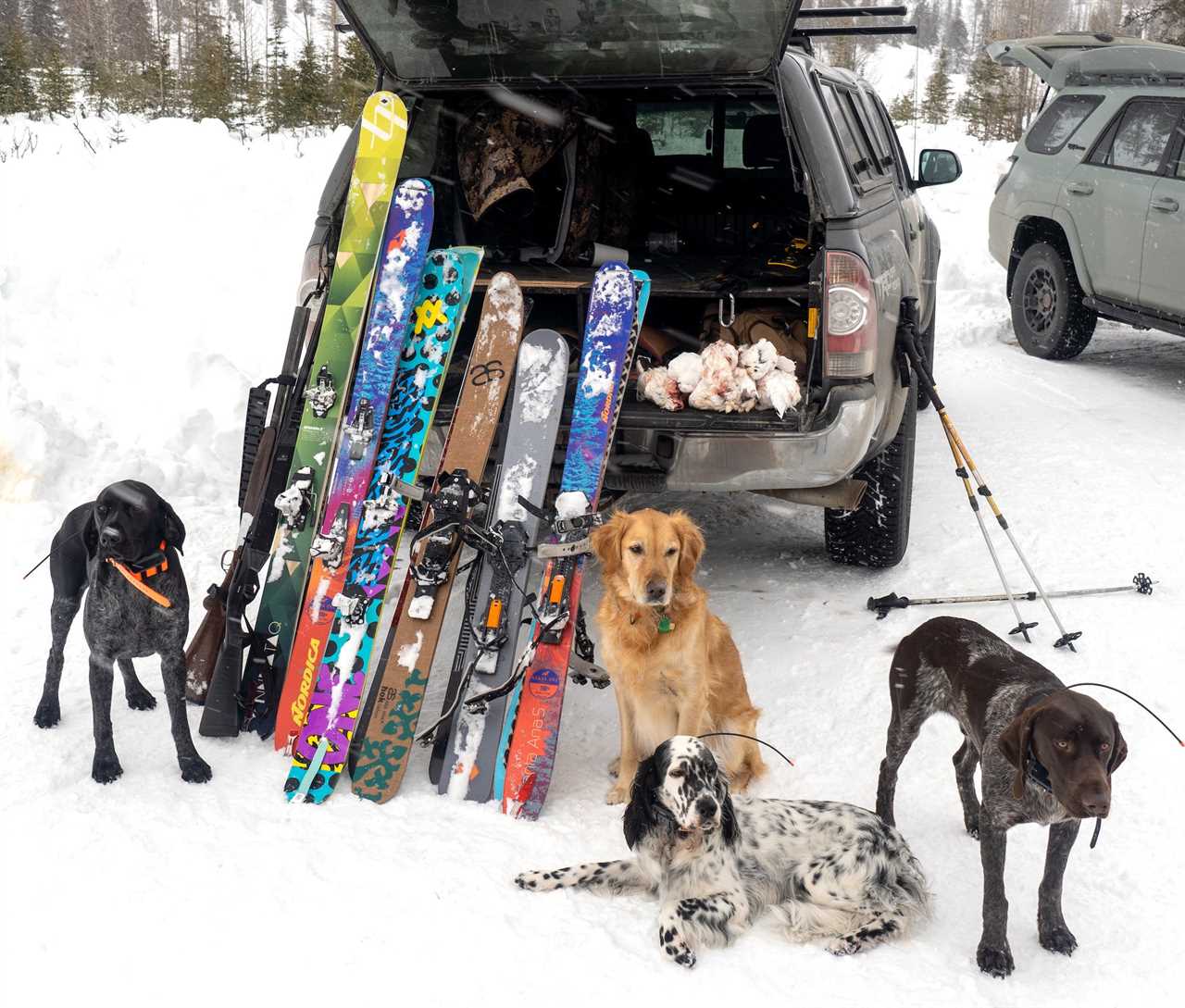
Ski setups for hunting can be as varied as bird dog breeds, which means that some of these grown men are hunting from skis designed for girls. There’s a reason that Wadsworth’s ideal setup includes children’s powder skis: They’re short. The ideal ski for upland work comes up only to the hunter’s sternum, allowing for better maneuverability. Hunters who repurpose their longer alpine skis sacrifice some of that maneuverability, but beefier powder skis allow the rider to float on top of the snow better. Wadsworth likes his skis wider than his foot.
Skis, from left: Overby’s beefy freeride alpine-touring setup; Wadsworth’s girls’ resort skis with ski mountaineering bindings; Janowski’s children’s heli powder skis with ski mountaineering bindings; Reilly’s Altai Hok skin-skis; Spolyar’s loaner set of Black Diamond Glidelite skin-skis; Johnson’s girls’ resort skis with universal strap bindings. All this gear isn’t cheap, but it’s about half the price of an alpine-touring setup. Wadsworth’s perfect recipe costs around $1,300 total, which includes full-price skis ($500), skins ($150), boots ($400), and bindings ($250). Poles would cost at least another $50. But that high-end setup isn’t necessary. He started ski-hunting on a pair of $100 army-surplus skis and still maintains that no one should pay over $200 for hunting skis. (He bought his $500 girls’ skis half-off during a closeout sale.) He also encourages others to look for used or discounted skins. Instead, Wadsworth advises, spend your money on ski boots. “I encourage all skiers in all genres to never skimp on boots,” he says. “Don’t look at the price. Buy the thing that feels so good even if it’s $700. Boots are worth every dime.
Dogs from left: Bruce, Janowski’s German shorthaired pointer; Cilo, Overby’s golden retriever; Sam, Reilly’s Ryman setter; and Riker, Johnson’s German shorthaired pointer after a successful ptarmigan hunt in the Talkeetna Mountains. Peter Wadsworth
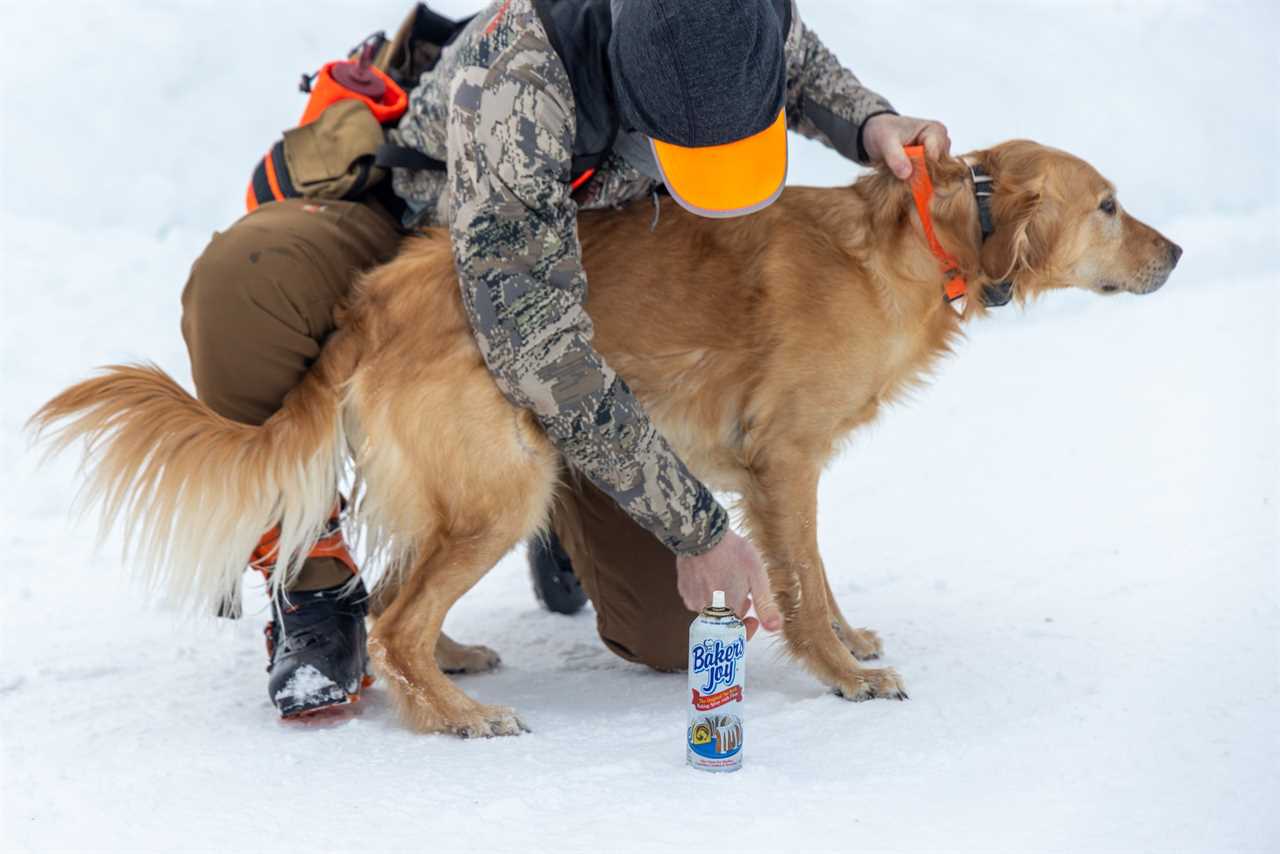
Overby coats his golden retriever’s paws in cooking spray and flour to prevent heavy snow from accumulating in her fur. He once ended a hunt early because the snowballs were hindering Clio’s movement, but a dog groomer who happened to be hunting with them that day suggested this game-changing tip. Now Clio, the group’s designated flusher, is able to hunt all day without getting weighed down by snow clumps the size of softballs. Peter Wadsworth
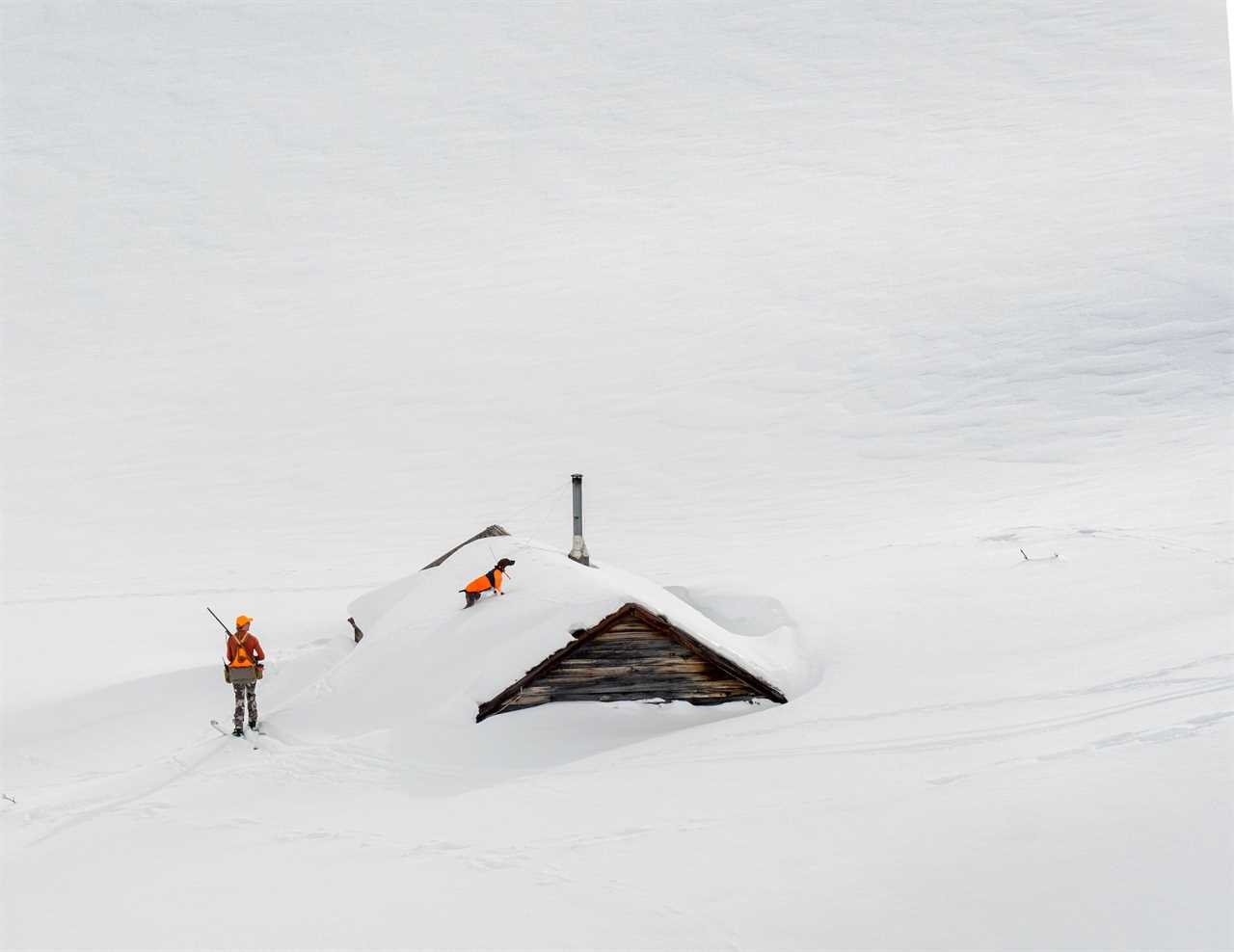
Janowski and Olive, a German shorthaired pointer, check out a buried mining camp. Olive is a hot, all-business bird dog when there are birds in the area. If the hunters spot ptarmigan tracks in the snow, Wadsworth can line her up like a duck dog and send her up to 300 yards away to check out the alders. And if she sweeps through without a point, the group can assume those were yesterday’s tracks and the birds have moved along. Wadsworth says she will also peg a bird 1,000 feet upslope, then throw her infamous “look-back” that says: “I found a bird. Are you coming?” Whenever this happens, Wadsworth and his buddies play a frantic game of nose-goes to determine the unlucky hunter who has to follow Olive up the mountain. The only reasons they won’t give chase are if the sun is setting, the slope is so steep they’d risk an avalanche, or they’ve already limited out. Peter Wadsworth
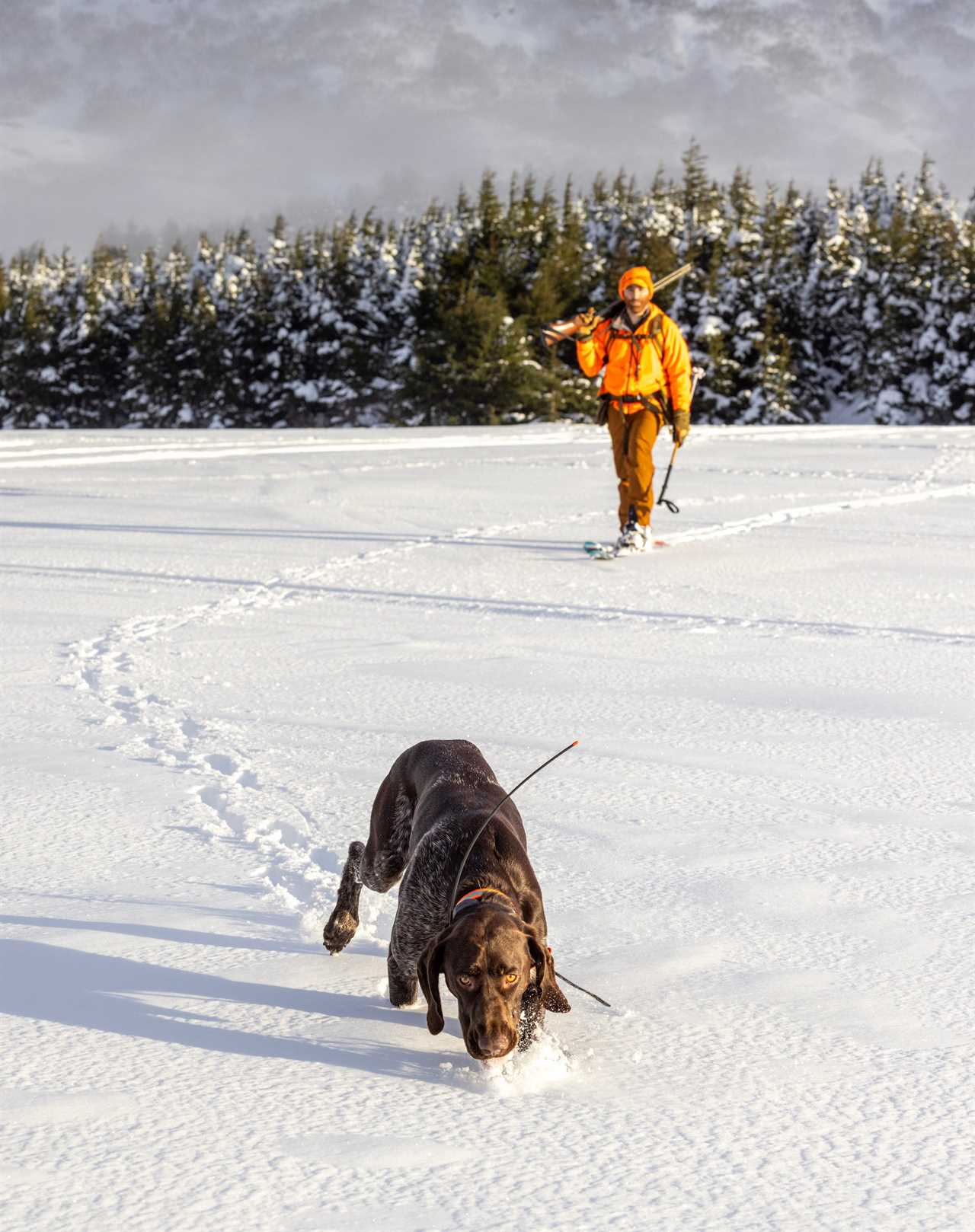
Riker sniffs out ptarmigan for lifelong bird hunter Scott Johnson, Wadsworth’s hunting mentor and his first convert to ski-hunting. Ptarmigan will “snow roost” during a snowstorm, meaning once the weather turns, they hole up and let new snow fall on top of them as they wait out the storm. They often explode from beneath undisturbed snow the next day, or even several days later, hungry and thirsty. Peter Wadsworth

Janowski points out a far-ranging dog to Johnson in the Chugach Mountains. Ptarmigan can find food and cover almost anywhere, but access to water is limited in deep snow packs. Janowski’s 4-year-old GSPs, Olive and Bruce, frequently work creeks in valley bottoms, looking for thirsty birds. Wadsworth will follow 50 feet above the dogs in these valleys so that when one dog goes on point, he can quickly close the distance by sliding downhill on skis, instead of making an exhausting double-time trudge in snowshoes. While the water in this area is obvious in the photo, sometimes snow conceals it so that only the dogs know it’s there. Peter Wadsworth

A white-tailed ptarmigan sits camouflaged in the snow, hoping the hunting party doesn’t spot it. Wadsworth’s crew mainly hunts willow ptarmigan because they roost in the flats. White-tailed and rock ptarmigan usually live on steeper slopes, but after a big storm—when Wadsworth prefers to hunt—some will have escaped to the valleys. Due to avalanche concerns, he stays off steep slopes with his dogs. These hunters cover anywhere from 6 to 15 miles a day on skis; the ptarmigan are hard to find, but they rarely fly away. Red hawks are the birds’ main predator, so a ptarmigan will typically take its chances with one dog, or more often a coyote, on the ground rather than risk death by beak and talon. Peter Wadsworth
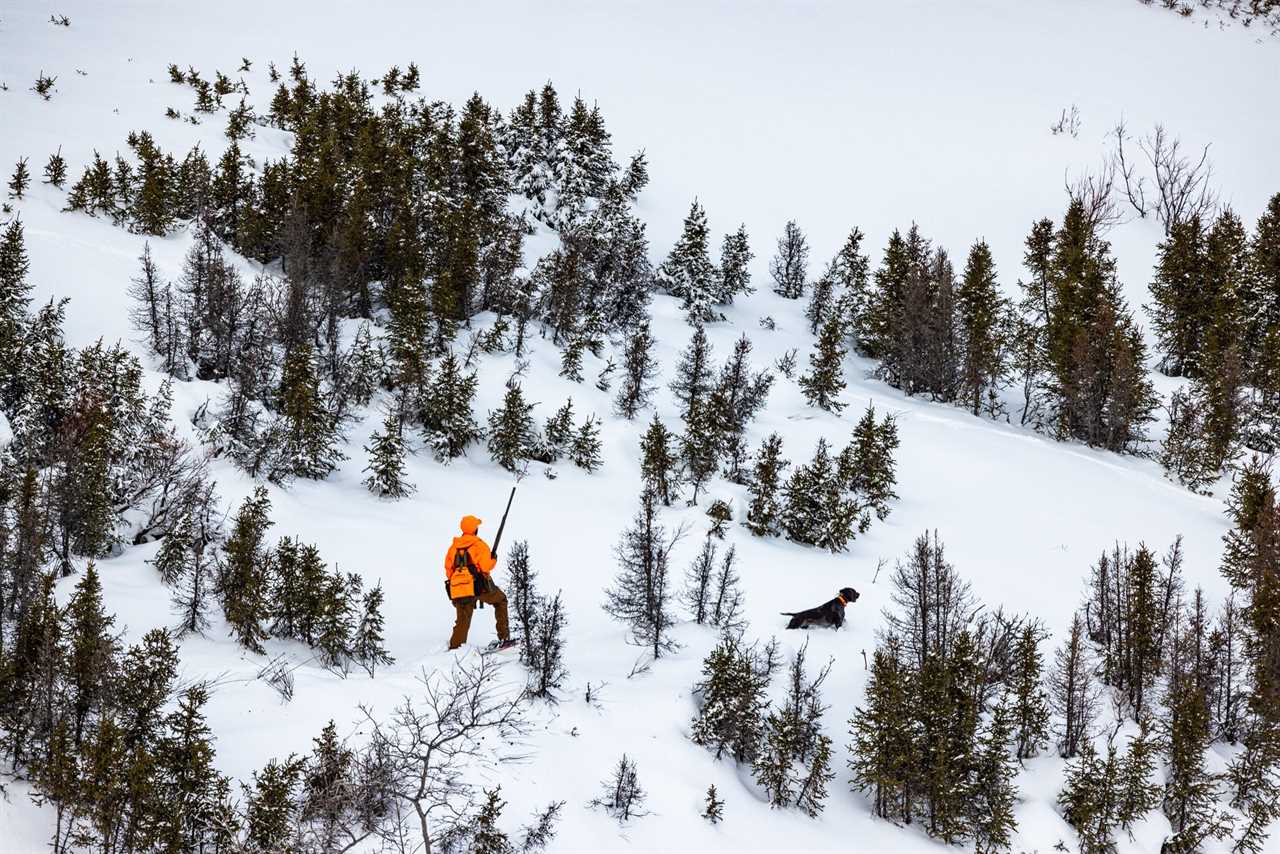
Johnson approaches Riker, who waits patiently on point. Shorter skis, which Johnson favors, are crucial for navigating tight brush and bushwhacking. They still give him an edge over snowshoes, however, and let him keep up with the dogs. And in Alaska’s elusive winter shooting light—sometimes as short as four hours in December—time is of the essence. Peter Wadsworth
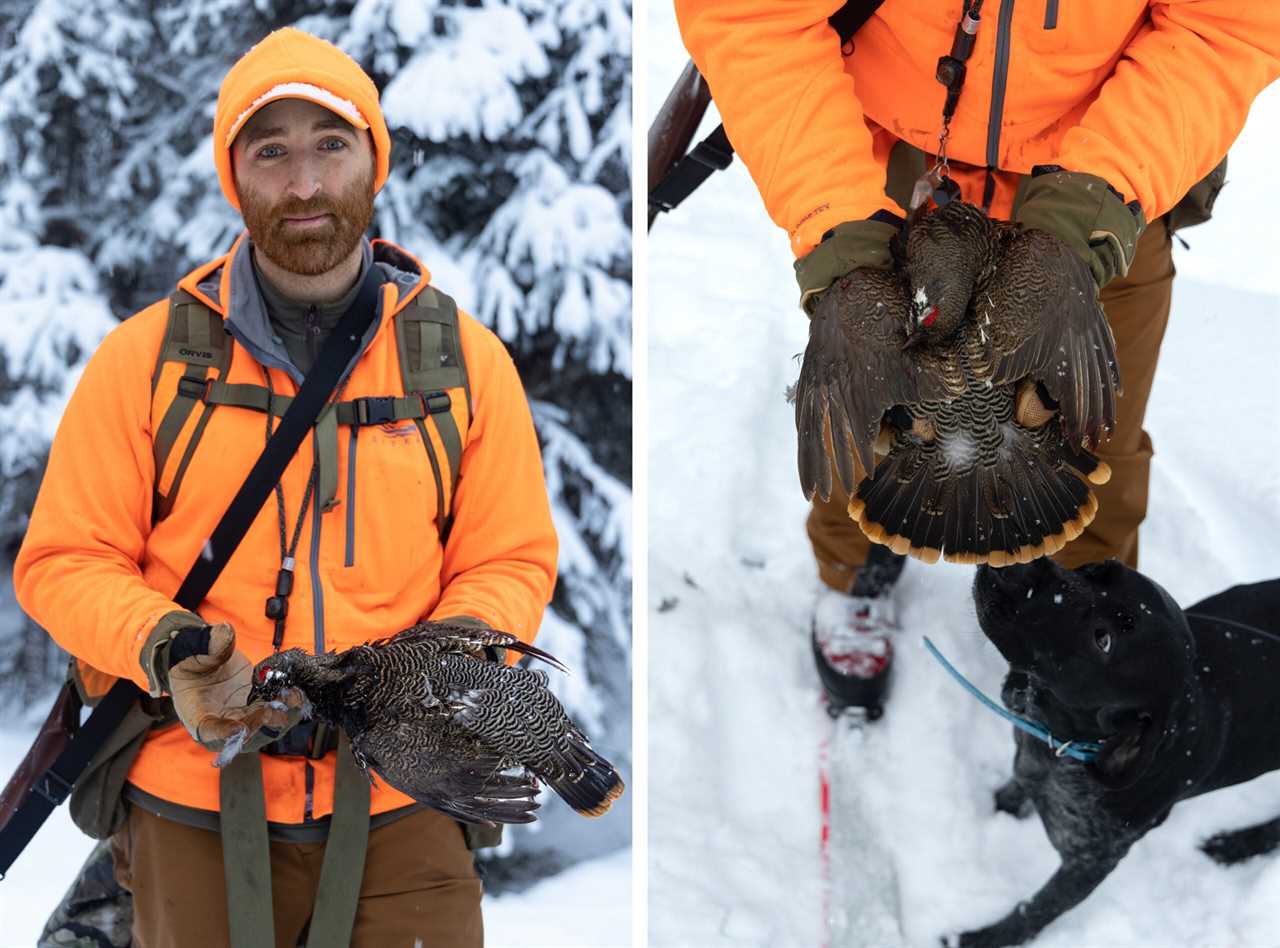
Johnson with a male spruce grouse; Bruce supervises closely. Scott considers these “consolation birds” while hunting ptarmigan or ruffed grouse. Sprucies, which are known for sitting in trees instead of flushing, aren’t as challenging for diehard wingshooters to hunt, or as tasty as other birds, but they’re great for working young dogs, and they’re plentiful in Southcentral Alaska. Peter Wadsworth
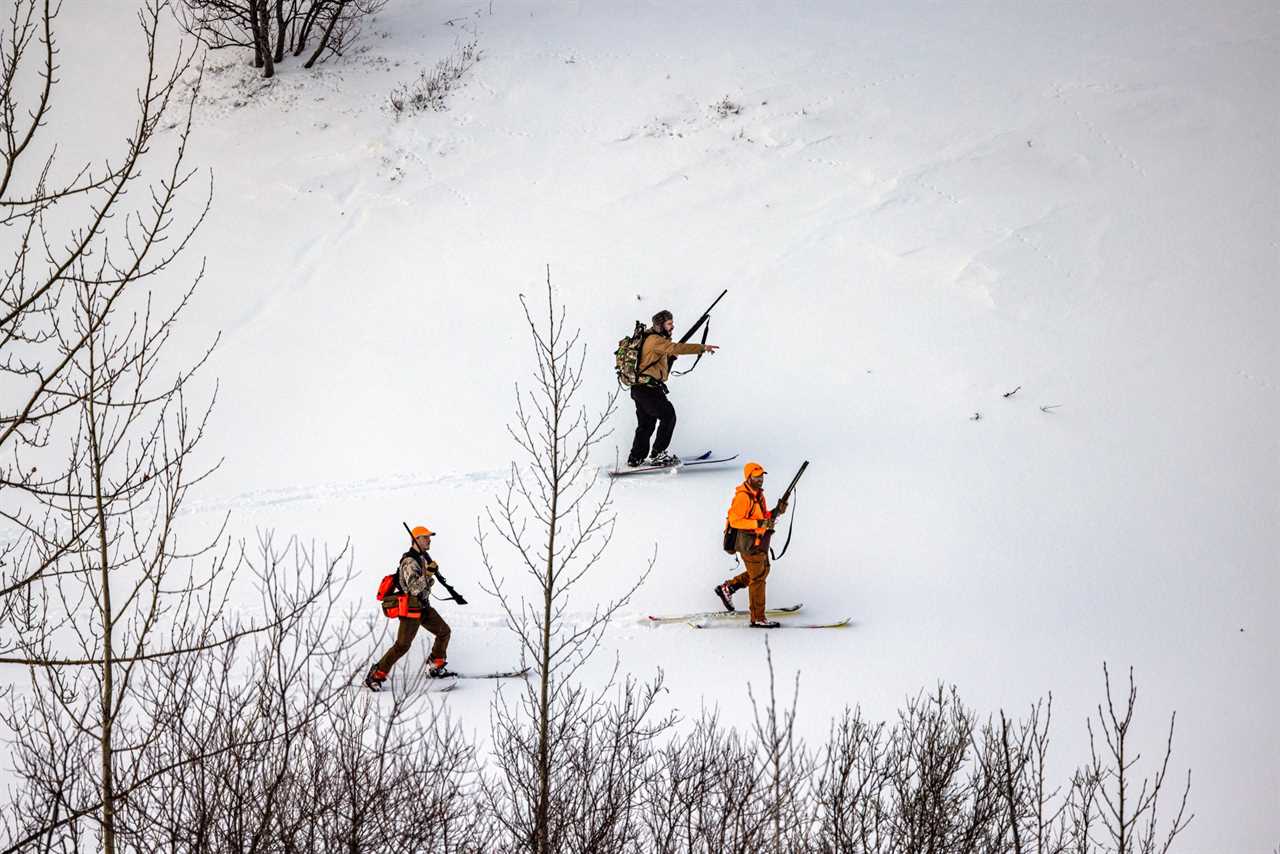
Kevin Lewellyn points out a dog on point and a running covey of ptarmigan to Overby (left) and Johnson (right). The pursuit begins. There are safety concerns to keep in mind when skiing with a shotgun, but they aren’t what you might think: Wadsworth and his buddies keep their guns unloaded until a dog goes on point, and their skins provide good control and stability while shooting. The biggest danger that must be taken into account is an avalanche, which can be fatal.
While backcountry skiers are usually abreast of avalanche danger because they incur the most risk, hunters, snowshoers, and snowmobilers sometimes skimp when it comes to avalanche awareness. Wadsworth has more avalanche education than most and teaches courses to local hunters, but he thinks everyone should know two key rules. First, measure the angles of the slopes around you and only venture onto those that are 20 degrees or less. Second, respect rapid change in the snowpack. Give the backcountry a day or three to settle after a new storm, high winds, rain, and so on.
Dogs don’t know about avalanche danger, and if they get birdy below a dangerous slope, it’s the handler’s job to rein in their dog. But with the right gear and conditions, winter upland bird hunting is worth the risk. According to Wadsworth, there’s not much that beats the sight of a covey bursting from the snow. Peter Wadsworth
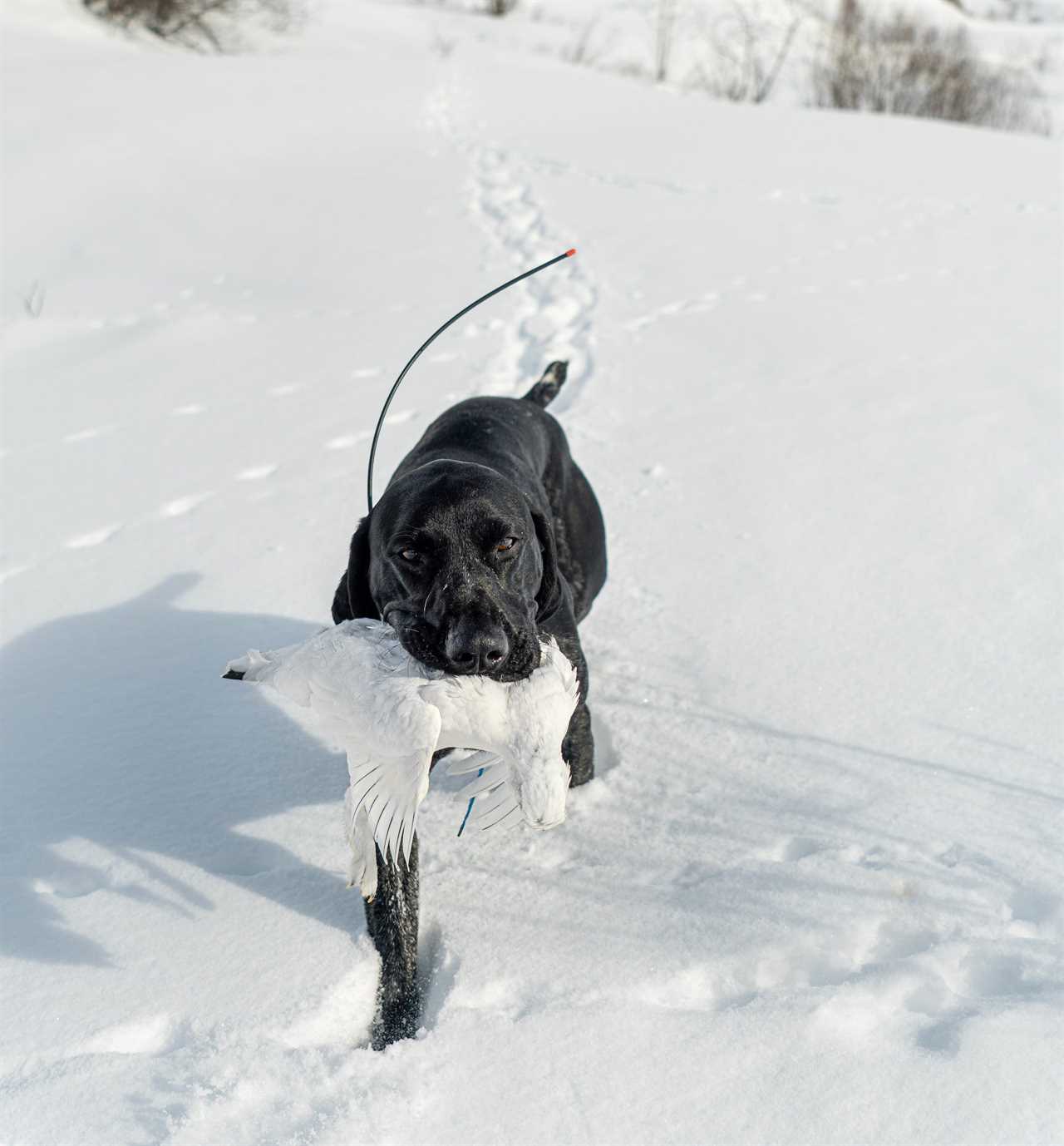
Bruce returns with a willow ptarmigan. An adept skier but relatively new dog trainer and hunter, Wadsworth has now converted several members of his local North American Versatile Hunting Dog Association chapter to the ski-hunting lifestyle. Now he ski-hunts around 20 days a season. He hunts mostly on weekends, but in the spring there’s sometimes enough light to go out after work (Alaska’s ptarmigan season is open as late as May in some units). Peter Wadsworth

From left: A white-tailed ptarmigan, a ruffed grouse, a willow ptarmigan, and a snowshoe hare make for a challenging Alaskan mixed bag. While the skis in this photo are mounted with expensive ski mountaineering bindings (which Wadsworth calls “overkill—beautiful overkill”) he has recently deemed the $250 Rottefella XPlore bindings the best for ski-hunting. Peter Wadsworth
The post These Renegade Hunters Are Skiing into the Backcountry with Their Bird Dogs appeared first on Outdoor Life.
Articles may contain affiliate links which enable us to share in the revenue of any purchases made.
By: Peter Wadsworth and Ashley Thess
Title: These Renegade Hunters Are Skiing into the Backcountry with Their Bird Dogs
Sourced From: www.outdoorlife.com/hunting/ski-hunting-birds/
Published Date: Sat, 04 Mar 2023 00:03:59 +0000
----------------------------------------------
Did you miss our previous article...
https://manstuffnews.com/weekend-warriors/best-rifle-bipods-of-2023-tested-and-reviewed
 Backyard GrillingWeekend WarriorsAdvice from DadBeard GroomingTV Shows for Guys4x4 Off-Road CarsMens FashionSports NewsAncient Archeology World NewsPrivacy PolicyTerms And Conditions
Backyard GrillingWeekend WarriorsAdvice from DadBeard GroomingTV Shows for Guys4x4 Off-Road CarsMens FashionSports NewsAncient Archeology World NewsPrivacy PolicyTerms And Conditions
